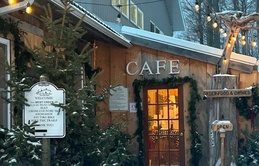
Shipwreck Whiskey: What’s Happening with the Westmoreland and its High-Proof Treasures?
The process of salvaging the 170-year-old shipwreck
By Greg Tasker | Dec. 2, 2023
Few shipwrecks in the Great Lakes pique the fascination of armchair treasure hunters as much as the Westmoreland, a cargo-laden passenger steamer that met its doom in the icy waters of the Manitou Passage off the Leelanau Peninsula in 1854.
Bound for Mackinac Island on its last voyage of the year, with provisions (and possibly pay) for soldiers at Fort Mackinac, the 200-foot-long ship foundered in an early December snowstorm, taking on frigid water and sinking to the bottom of Lake Michigan with, legend has it, $20 million in gold coins (in today’s currency) and a priceless cache of rare whiskey. Overall, 17 people perished; another 17 survived.
The search for those underwater treasures began decades ago, and fascination with the Westmoreland intensified when Lake Ann resident Ross Richardson discovered the shipwreck sitting upright on the floor of Platte Bay in 2010. That interest reached a fervor earlier this year when Richardson announced his plans to salvage the whiskey and other treasures from the ship over the summer.
That salvage—despite the international publicity—has yet to happen. Richardson wasn’t able to pursue that work over the summer and is in the process of obtaining the necessary permits from the state of Michigan. To date, no artifacts have been removed from the shipwreck, which rests 180 feet below the surface.
A Taste of History
Richardson, an avid shipwreck hunter who chronicled his fascination in a book, The Search for the Westmoreland: Lake Michigan’s Treasure Shipwreck, has partnered with Ari Sussman and Chad Munger from Mammoth Distilling in his effort to salvage artifacts from the ship. Sussman is the head distiller at Mammoth Distilling and Munger is the CEO.
“We want to do things legally and ethically,” says Richardson, who has made more than 60 dives to the Westmoreland, which rests about 2.5 miles from the shores of Sleeping Bear Dunes National Lakeshore. “We want to make sure we put our best foot forward. We’re trying to share history and tell stories. We all have a deep love of Michigan history.”
Their quest is twofold: Retrieve and preserve any artifacts culled from the ship, and use some of the salvaged wood to age and flavor whiskey.
“There’s a piece of broken hull we’d like to recover and cut into staves and toast and create a barrel … Mammoth would like to produce a whiskey flavored by the shipwreck wood,” Richardson says. “The Westmoreland was made of white oak. Those trees were 300 to 400 years old when the ship was built.
“The idea is to take forgotten wood on the bottom of the lake and share the story of this wreck … to be able to smell and taste history,” he adds.
Mammoth is excited about the prospect of that project, even if it’s still years away. “It’s an honor to partner with Ross on this project. His commitment to documenting our maritime history is truly inspiring,” Sussman says. “Hopefully, our collaboration—and shipwreck whiskey—will draw attention to the challenges of preserving these rapidly deteriorating underwater time capsules.”
And what about whiskey barrels already on board? Richardson says it’s hard to guess the status of the whiskey—water might have seeped in, for example. Mammoth has plans to test any surviving whiskey to determine its composition.
“We believe the whiskey is in the cargo area,” Richardson says. “We think the cargo hold is full of priceless antiques from 1854—muskets, uniforms, steamer trunks—all perfectly preserved in the low oxygen environment of the hold. It’s protected from currents and other things that would normally make things decay. The year-round temperature in the hold is 39 degrees.”
The End of an Era
The salvaging of the Westmoreland, Richardson says, will be a years-long project, one that will require the expertise of a salvage company for the work.
“It’s a very complicated process dealing with a ship from the 1850s. It’s very dangerous and something we’d want a professional salvage company to handle,” says Richardson, who frequently travels the state to talk about Great Lakes shipwrecks and maritime-related mysteries. He is also a board member of the Maritime Heritage Alliance.
“As part of this project, we want to change the culture of shipwrecks and artifact preservation in the Great Lakes. We’re coming to an end of an era of shipwreck hunting and discovery,” he adds. “Due to the limited number of shipwrecks and increasing technology, almost every shipwreck is going to be found in the next 10 years. We will know where all of them are.”
He says he’d like to see artifacts preserved in a climate-controlled environment and on display for the public at a museum. One museum of interest in the Empire Area Museum Complex; Empire is the closest community to the shipwreck and the gateway to the nearby national lakeshore.
“The question is what do we do with the priceless artifacts?” Richardson asks. “We’re going to try and lead the charge and set a good example. We’re going to preserve these artifacts and share them with the public without a cost. It’s a noble cause.”
Time, however, is a concern. As the ruins linger at the bottom of Lake Michigan, Richardson is concerned about the hastening decaying process and its toll on the wooden remains. The wreck is encrusted with quagga mussels, which are causing damage to the remains. They’ve also impacted the lake ecosystem—the water is clearer but sunlight is able to penetrate deeper, warming temperatures, causing decay to happen more quickly.
While there is a possibility modern-day pirates could find and loot the shipwreck site, Richardson believes it’s unlikely.
“Every diver I’ve dealt with has been on the up and up and understands the importance of historical sites,” he says. “Most shipwrecks are graveyards. I think people understand that.”
A Time Capsule
Chris Roxburgh, an underwater photographer and diver who has explored the shipwreck and completed a full photoshoot of the vessel, finds the Westmoreland particularly special among the countless Great Lakes shipwrecks.
“I think it’s one of the greatest shipwrecks in all of the Great Lakes,” he says. “It’s a true treasure ship and the story, the sinking, the survivors … It was quite a harrowing tale. There are a lot of shipwrecks out there that most people don’t know about. To me, the Westmoreland is just as important as the (Edmund) Fitzgerald. Fitzgerald has gotten so popular because of the song written about it.”
The Westmoreland is the only shipwreck he has visited with the vessel’s hogging arches, on either side of the hull, fully intact.
“It’s in really good condition—one of the better conditions I’ve seen among the wrecks I’ve been on,” he adds. During his dives, Roxburgh was able to see some artifacts, including plates and an ornate water jug on the deck. “It still has its wheel on it and the anchor hangs off of it … it’s like a time capsule.”
And the gold? No signs of it yet.
“Gold? That’s the legend,” Richardson says. “Most legends are based on some fact. Is there gold on the ship? Probably. How much and where it is? We don’t know.”
Photo by Chris Roxburgh
Trending

Welcoming the Winter Solstice: Rituals & Events for the Shortest Day of the Year
With the winter solstice quickly approaching, it’s hard not to notice how dark each day feels. Astronomically, this is… Read More >>
Camp Greilick Now Open!
It’s been a long road for the century-old Camp Greilick, which, after several dormant years, was acquired by Grand Tra… Read More >>
Men and Ugly Sweaters
Those two things don’t always go together, but on Dec. 19, you’ll see both out and about in Petoskey and Harbor … Read More >>


